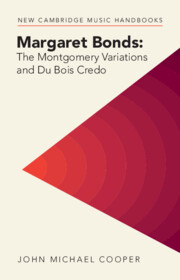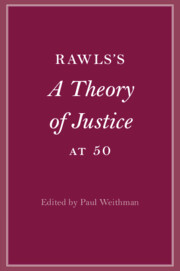Refine search
Actions for selected content:
34 results
1 - The Making of Martin Luther King Jr.’s African Consciousness, 1929–1954
-
- Book:
- Beyond Borders
- Published online:
- 27 December 2025
- Print publication:
- 08 January 2026, pp 7-27
-
- Chapter
- Export citation
How Americans Evaluate Redistributive vs. Symbolic Racial Justice Policies
-
- Journal:
- Journal of Race, Ethnicity and Politics , First View
- Published online by Cambridge University Press:
- 11 November 2025, pp. 1-14
-
- Article
-
- You have access
- Open access
- HTML
- Export citation

Racial Justice in American Land Use
-
- Published online:
- 19 September 2025
- Print publication:
- 09 October 2025
19 - Reconstructing the First Amendment
- from Part V - Identifying Performers of the Press Function
-
-
- Book:
- The Future of Press Freedom
- Published online:
- 25 July 2025
- Print publication:
- 24 July 2025, pp 309-324
-
- Chapter
-
- You have access
- Open access
- HTML
- Export citation
The World House Remodeled: Toward Beloved Community Through Housing Justice
-
- Journal:
- Journal of Law and Religion / Volume 39 / Issue 3 / September 2024
- Published online by Cambridge University Press:
- 04 July 2025, pp. 417-448
-
- Article
-
- You have access
- Open access
- HTML
- Export citation

Toward an Abolitionist Human Rights Court
- Rethinking Responses to Gendered and Racialized Violence
-
- Published online:
- 22 May 2025
- Print publication:
- 03 July 2025
-
- Element
- Export citation
Community perspective analysis: Informing the design of a community-academic research readiness protocol
-
- Journal:
- Journal of Clinical and Translational Science / Volume 9 / Issue 1 / 2025
- Published online by Cambridge University Press:
- 28 April 2025, e124
-
- Article
-
- You have access
- Open access
- HTML
- Export citation
Introduction
-
- Book:
- American Grasslands
- Published online:
- 06 February 2025
- Print publication:
- 13 February 2025, pp 1-10
-
- Chapter
- Export citation
10 - The Reckoning
-
- Book:
- American Grasslands
- Published online:
- 06 February 2025
- Print publication:
- 13 February 2025, pp 165-185
-
- Chapter
- Export citation
The Currency of Racial Justice
-
- Journal:
- Legal Theory / Volume 30 / Issue 4 / December 2024
- Published online by Cambridge University Press:
- 19 March 2025, pp. 229-254
- Print publication:
- December 2024
-
- Article
- Export citation
6 - Online Racial Justice Advocacy
- from Part I - Organizing and Activism
-
-
- Book:
- The Cambridge Handbook of Community Empowerment
- Published online:
- 18 April 2024
- Print publication:
- 25 April 2024, pp 162-190
-
- Chapter
- Export citation
31 - Antiracist Moral and Civic Education
- from Part III - Emerging Ethical Pathways and Frameworks
-
-
- Book:
- The Cambridge Handbook of Ethics and Education
- Published online:
- 07 March 2024
- Print publication:
- 14 March 2024, pp 657-675
-
- Chapter
- Export citation
2 - Civic Actions with a Purpose
-
-
- Book:
- Young Black Changemakers and the Road to Racial Justice
- Published online:
- 08 February 2024
- Print publication:
- 15 February 2024, pp 15-32
-
- Chapter
- Export citation
Quantifying “Community Power” and “Racial Justice” in the Medical-Legal Partnership Literature
-
- Journal:
- Journal of Law, Medicine & Ethics / Volume 51 / Issue 4 / Winter 2023
- Published online by Cambridge University Press:
- 13 March 2024, pp. 748-756
- Print publication:
- Winter 2023
-
- Article
- Export citation
Using Racial Justice Principles in Medical-Legal Partnership Design and Implementation
-
- Journal:
- Journal of Law, Medicine & Ethics / Volume 51 / Issue 4 / Winter 2023
- Published online by Cambridge University Press:
- 13 March 2024, pp. 757-763
- Print publication:
- Winter 2023
-
- Article
-
- You have access
- Open access
- HTML
- Export citation

Margaret Bonds: The Montgomery Variations and Du Bois Credo
-
- Published online:
- 30 November 2023
- Print publication:
- 30 November 2023
3 - The Text and Music of the Credo
-
- Book:
- Margaret Bonds: <i>The Montgomery Variations</i> and Du Bois <i>Credo</i>
- Published online:
- 30 November 2023
- Print publication:
- 30 November 2023, pp 77-120
-
- Chapter
- Export citation
20 - Reproductive Justice after the Pandemic
- from Part V - Opening New Pathways for Health Care Delivery and Access
-
-
- Book:
- COVID-19 and the Law
- Published online:
- 27 October 2023
- Print publication:
- 09 November 2023, pp 303-316
-
- Chapter
-
- You have access
- Open access
- HTML
- Export citation
Chapter 5 - Feminisms
- from Part I - Ideologies and Movements
-
-
- Book:
- The Cambridge Companion to the Twentieth-Century American Novel and Politics
- Published online:
- 07 October 2023
- Print publication:
- 12 October 2023, pp 78-93
-
- Chapter
- Export citation

Rawls’s A Theory of Justice at 50
-
- Published online:
- 20 July 2023
- Print publication:
- 10 August 2023
